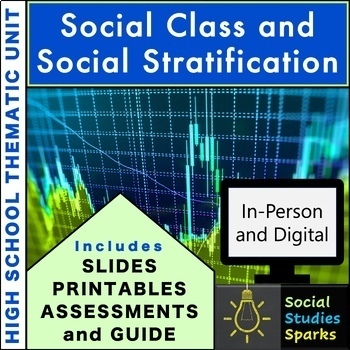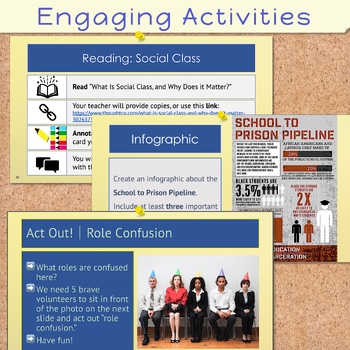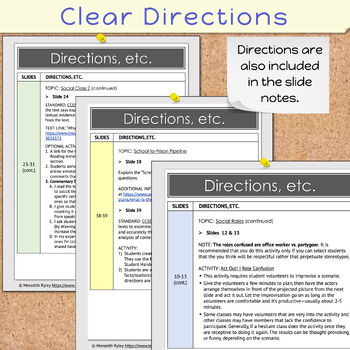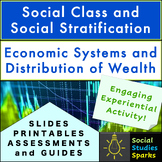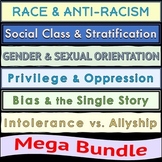Social Class & Social Stratification Unit - High School Sociology, Economics +
- Zip
- Easel Activity
- Easel Assessment
Also included in
- Throw 100 pennies down and let the learning begin! Use a compelling experiential activity to start an exploration of the elusive “class” in race, class, and gender. This bundle includes a comprehensive unit on SOCIAL CLASS AND SOCIAL STRATIFICATION along with WHO GETS WHAT?, an engaging lesson aboutPrice $18.40Original Price $23.00Save $4.60
- Race, Class, and Gender — together at last! Comprehensive thematic units on Race and Anti-Racism, Gender and Sexual Orientation, and Social Class and Social Stratification with super-engaging activities. These resources will help you integrate complex social justice issues with your content. The intPrice $65.00Original Price $83.50Save $18.50
- Relevant and versatile—provides interactive social justice lessons that help students understand complex topics. Comprehensive thematic units include Race and Anti-Racism, Social Class and Stratification, Gender and Sexual Orientation, Privilege and Oppression, Bias and the Single Story, and IntolerPrice $99.75Original Price $137.50Save $37.75
Description
Address the elusive “class” in race, class, and gender! This comprehensive thematic unit on Social Class and Social Stratification provides lessons that are organized in a step-by-step manner that helps students comprehend complex concepts. LOW PREP (print and go) — includes plans, slides with activities, PDF worksheets, and assessments. High School resource that could be used in 8th grade and work for digital learning. Infuse these lessons into multiple courses such as Economics, Sociology, Ethnic Studies, or English.
This unit has engaging lessons that help you address topics that can be sensitive with a respectful approach. Topics include: 1) Social Structures, 2) Social Stratification, 3) Social Inequalities, and 4) Social Justice. The unit ends with an essay on cooperation vs. competition.
The concepts covered include social status, ascribed status, achieved status, status inconsistency, social role, role conflict, role confusion, socioeconomic status (SES), social stratification, social class, income, wealth, upper class, upper-middle class, middle class, working class, working poor, underclass, social mobility, caste stratification systems, open stratification systems, meritocracy, privilege, and institutional discrimination.
The resource includes:
- A PowerPoint with 65 slides that includes 24 terms and multiple activities
- A 60-page guide with easy, step-by-step directions that includes objectives, essential questions, and standards
- An editable terms and definitions handout
- A multiple-choice test, with a key, in editable Word and Easel versions
- A privilege statements survey
- An infographic project on the school-to-prison pipeline with a Research Worksheet handout
- A Close Watching: Video Response Notes handout
- Close Reading Annotations cards for readings about topics that include cooperation vs. competition
- An Explanatory Essay Organizer for a five-paragraph essay on competition vs. cooperation
- Culminating Reflection Questions
*For copyright reasons, the materials in this resource are NOT editable with the exception of specific components that are labeled as editable. You ARE able to insert text boxes and images on slides, rearrange them, and add your own.*
The slides can be imported into Google Slides, Nearpod, or Pear Deck to enhance digital learning and/or to add activities such as discussions and polls.
Directions are clear and concise, and the resource includes graphic organizers to help you serve students with special needs. The multiple-choice test is editable to allow you to differentiate the assessment.
IMPORTANT NOTE: While teaching online during the pandemic, I began to utilize short video clips for instruction. They were particularly impactful when addressing social justice issues due to their visceral nature. Because of their effectiveness, I have incorporated them into my curriculum, so this resource includes links to short videos. I suggest that you consider your ability to show videos to students when making a decision about purchasing this resource.
Save money! This unit can also be purchase as part of a Mini-Bundle that includes an engaging experiential activity: Social Class & Social Stratification Unit w/ Interactive Who Gets What? Lesson. The resource includes a Civil Deliberation (the respectful exchange of ideas with the goal of presenting and hearing multiple perspectives in order to understand an issue and answer a question).
I also have comprehensive units on:
• Gender and Sexual Orientation
Save big and get a bonus with this bundle! Race, Class, & Gender Units - Interactive Lessons, High School, Slides, Digital
If you try my resource, I would love to hear any questions or suggestions that you have. I would also appreciate your writing a review—you’ll receive TPT credits to apply to future purchases! Thank you.
“Social class is probably the single most important variable in society. From womb to tomb, it correlates with almost all other social characteristics.” —James W. Loewen in Lies My Teacher Told Me
OBJECTIVES
- Articulate how economic resources should be allocated in the United States, and why should they be divided in that manner. (Introduction)
- Identify the definitions of terms related to social structures, social stratification, inequalities, and social justice. (Sections 1-4)
- Describe and discuss the concepts of social status and social roles. (Section 1)
- Identify the factors that define each of the six social classes. (Section 2)
- Analyze the concepts of privilege, institutionalized discrimination, and meritocracy. (Section 3)
- Investigate challenges that low-income people face and reflect on cooperation vs. competition. (Section 4)
ESSENTIAL QUESTIONS
- How should economic resources be allocated in the United States, and why should they be divided in this manner?
- What are the definitions of the terms related to social structures, social stratification, inequalities, and social justice?
- What are types of social status and what are examples of role conflict and role confusion?
- What are the factors that define each of the six social classes?
- What are examples of privilege, institutionalized discrimination, and meritocracy?
6.a. What is the school-to-prison pipeline?
6.b. What is more productive, cooperation or competition?

